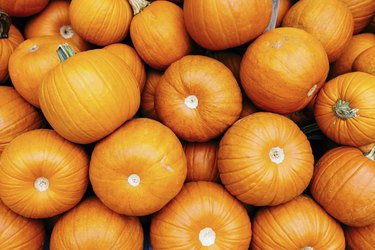
During their peak season in the autumn, pumpkins are among the most economical vegetables to buy. You can use them in any recipe calling for winter squash, or puree them for traditional baked goods including pumpkin pies, muffins and cookies. Many frugal cooks take advantage of their low price and nutritional value by freezing the pumpkin for later use in winter and spring. Once thawed, the frozen pumpkin is almost as versatile as fresh.
Freezing Pumpkins
Video of the Day
Not all pumpkins are alike, so how you freeze them is largely dictated by how you plan to use them. Big jack o' lantern pumpkins have a stringy and mild-flavored flesh. They're best used as a vegetable in soups and stews, where they'll absorb flavor from the broth, so freeze them in diced portions. Smaller "pie pumpkins," with their denser, darker flesh, can be used as a vegetable but are also ideal for pureeing and baking. Freeze them diced, or puree them and measure the puree into portions of one or two cups, as called for in your favorite recipes. Whether you're freezing pumpkin pieces or freezing pumpkin puree, small, flat bags or containers freeze and thaw more efficiently than deep or thick ones.
Video of the Day
Thawing Diced Pumpkin
The best way to thaw any food, according to the U.S. Department of Agriculture, is to simply leave it in your fridge until it's defrosted. A small package of diced pumpkin will usually thaw overnight, while larger ones might take 24 hours. A quicker alternative is thawing the pumpkin in cold water, which might take as little as an hour. If you use the cold water technique, cook or refrigerate the pumpkin as soon as it's thawed. You can thaw pumpkin pieces in the microwave if you need to use them immediately, or simply add them to a soup or stew while frozen.
How to Defrost Pumpkin Puree
The same four basic techniques can be used to thaw pumpkin puree, depending how quickly you want to use it. The refrigerator method is your best option, when time permits, because it keeps the pumpkin at a food-safe temperature throughout the thawing process. The thawed puree can safely stay in the fridge for three or four days after you've thawed it. Microwaving is a more suitable technique with puree than with diced pieces. The microwave heats unevenly as the food thaws; stop frequently to stir the puree to equalize the temperature and eliminate hot spots.
Using Thawed Pumpkin
The primary difference between using fresh pumpkin and using thawed is its texture. As pumpkin freezes, the expanding liquids burst the walls of many of its cells. As the pumpkin thaws, this moisture seeps from the ruptured cell walls and puddles in the freezer bag. If you're adding diced pumpkin to a soup, you can add the liquid along with it. However, if you're baking with it, you might prefer to squeeze out the excess moisture. Draining that liquid before cooking down pumpkin puree for pie filling gives you a thicker, drier puree in less time.